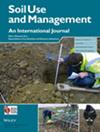Different organic farming systems under greenhouse do not improve soil C storage but affect microbial functions across soil aggregates
IF 3.7
3区 农林科学
Q1 SOIL SCIENCE
引用次数: 0
Abstract
Vegetable crops production is usually based on organic fertilizers purchased off-farm while the care of soil fertility based on the maintenance of adequate level of soil organic matter receives few attentions. Organic production in plastic tunnel-greenhouses represents the most intensified organic production system. Therefore, we compared four alternative organic production systems mainly characterized by the combination of fertilization practices based on compost, cover crops, and commercial organic fertilizers. The systems were: input substitution organic method (BAU), biodynamic method (BIODYN), organic-agroecological (AGROEC), and a not fertilized but organically managed control (CNT). The objective of this study was to explore in a 3-year long trial, the effects of different organic systems on soil organic carbon (SOC) balance and the possible effects on soil chemical-physical characteristics, enzymatic activities involved in the C, N, and P cycling, total bacterial biomass (16S rRNA), and the microbial functional genes cbbL and amoA in bulk soil and in three aggregate size fractions (macroaggregates >250 μm, free microaggregates 250-53 μm, and free silt plus clay (free-SC) < 53 μm). The conducive microclimatic conditions for soil microbial activities under the greenhouse, together with the transition towards a more intensive rotation and tillage, determined a decrease of the SOC stock (from 5.9 Mg C ha-1 in BIODYN to 10.8 in CNT) that was only partially balanced by C input distributed to soil (from 4.6 Mg C ha-1 in CNT to 31.6 in AGROEC). The different organic systems did not seem to directly affect chemical and microbial properties in the bulk soils. The higher SOC decline in CNT, however, resulted in the degradation of soil structure but at same time led to the increase of the FDAse in the bulk soil. At aggregate level, instead, more evident effects of organic systems were observed on both chemical-physical and microbial properties. The impact of organic systems on enzymatic activities differed in the different aggregate size classes while the effect on bacterial biomass and functional genes was the same in all aggregate size classes. Interestingly, the cbbL gene abundance in soil aggregates, especially in macroaggregates, was correlated positively to OC inputs (r = 0.82; p < 0.001). The amoA gene and bacterial biomass, instead, put in evidence for BIODYN, a significant decrease in soil aggregates that seemed to be related, particularly in macro and free microaggregates, to the low amount of total N content. In soil aggregates only AGROEC, compared to CNT, determined the increment of the phosphatase in macroaggregates, while BIODYN and BAU highlighted even lower values of β-d-glucosidase, β-d-glucosaminidase, and phosphatase in free-SC. In conclusion in high-input organic systems under tunnels, the misleading notion that a high supply of OC and TN through green manuring, compost amendment etc., improves per se soil health is challenged.温室下的不同有机耕作制度不会改善土壤的碳储存,但会影响整个土壤团聚体的微生物功能
蔬菜作物生产通常使用从农场外购买的有机肥料,而以保持足够的土壤有机质水平为基础的土壤肥力养护却很少受到重视。塑料隧道温室中的有机生产是集约化程度最高的有机生产系统。因此,我们对四种可供选择的有机生产系统进行了比较,其主要特点是结合了基于堆肥、覆盖作物和商业有机肥料的施肥方法。这些系统分别是:投入替代有机法(BAU)、生物动力法(BIODYN)、有机生态法(AGROEC)和不施肥但有机管理的对照(CNT)。这项研究的目的是通过一项为期 3 年的试验,探讨不同有机系统对土壤有机碳(SOC)平衡的影响,以及对土壤化学物理特性、参与碳、氮、磷循环的酶活性、细菌生物量(16S rRNA)、微生物功能基因 cbbL 和 amoA 的可能影响;250 μm,250-53 μm 的游离微团聚体,以及 53 μm 的游离粉土加粘土(free-SC)。温室中有利于土壤微生物活动的微气候条件,加上向更密集的轮作和耕作过渡,决定了 SOC 储量的减少(从 BIODYN 的 5.9 兆克 C/公顷-1,到 CNT 的 10.8 兆克 C/公顷-1),而分配到土壤中的 C 输入量(从 CNT 的 4.6 兆克 C/公顷-1,到 AGROEC 的 31.6 兆克 C/公顷-1)仅部分平衡了这一减少。不同的有机系统似乎并不直接影响大块土壤的化学和微生物特性。然而,中国国家公园中较高的 SOC 降幅导致了土壤结构的退化,但同时也导致了块状土壤中 FDAse 的增加。相反,在团聚体层面,有机系统对化学物理和微生物特性的影响更为明显。有机系统对酶活性的影响在不同粒径的团聚体中有所不同,而对细菌生物量和功能基因的影响在所有粒径的团聚体中都是一样的。有趣的是,土壤团聚体(尤其是大团聚体)中的 cbbL 基因丰度与有机碳投入量呈正相关(r = 0.82; p < 0.001)。相反,amoA 基因和细菌生物量则证明了 BIODYN 在土壤团聚体中的显著减少,这似乎与总氮含量较低有关,尤其是在大团聚体和游离微团聚体中。在土壤团聚体中,只有 AGROEC(与 CNT 相比)确定了大团聚体中磷酸酶的增加,而 BIODYN 和 BAU 则突出表明,游离微团聚体中的β-d-葡萄糖苷酶、β-d-葡萄糖苷酶和磷酸酶的值更低。总之,在隧道式高投入有机系统中,通过绿肥、堆肥改良等方式提供大量 OC 和 TN 可改善土壤健康的误导性观点受到了质疑。
本文章由计算机程序翻译,如有差异,请以英文原文为准。
求助全文
约1分钟内获得全文
求助全文
来源期刊

Soil Use and Management
农林科学-土壤科学
CiteScore
7.70
自引率
13.20%
发文量
78
审稿时长
3 months
期刊介绍:
Soil Use and Management publishes in soil science, earth and environmental science, agricultural science, and engineering fields. The submitted papers should consider the underlying mechanisms governing the natural and anthropogenic processes which affect soil systems, and should inform policy makers and/or practitioners on the sustainable use and management of soil resources. Interdisciplinary studies, e.g. linking soil with climate change, biodiversity, global health, and the UN’s sustainable development goals, with strong novelty, wide implications, and unexpected outcomes are welcomed.
 求助内容:
求助内容: 应助结果提醒方式:
应助结果提醒方式:


